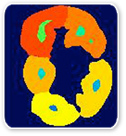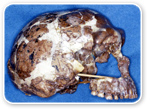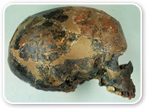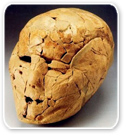 |
| |
Evolutionary trends in the
dentition
We are developing a computerized model
of hominid teeth to examine the way in which the
spatial and temporal localization of cell
division and differentiation in the tooth germ
is associated with developmental and
phylogenetic variation. This model is derived
from serial CT scans depicting the tooth germ,
visualized at the dentin-enamel interface and by
confocal microscope analyses of prism structure.

|
|
| |
|
| |
Identification of
developmental anomalies in utero and infancy
These studies are designed to investigate the
timing, duration and severity of specific
developmental disorders incurred in utero and in
infancy and their effect on growth and
development as expressed in anomalies of the
primary teeth. Development of the primary teeth
begins in the 6-8th week in utero. The
distinction between prenatal and postnatal
development, using the neonatal line, provides a
powerful diagnostic tool for distinguishing
between developmental insults occurring in utero
and those occurring in the neonatal period and
early infancy.


Palaeopathology
History of disease is an integral part of human
history. For diagnosing diseases in human
skeletal remains and their possible causes we
are using traditional morphological methods
along with the X-rays, CT-scans and ancient DNA
analysis. Several hereditary diseases, primarily
hemoglobinopathies, are highly prevalent in
populations residing in regions that have been
infested by malaria. Claims for the occurrence
of thalassemia in prehistoric populations have
been made on the basis of skeletal pathology. We
have detected a known mutation in the
ß-globin gene in the
skeletal remains of a child with severe porotic
hyperostosis.
|
|
| |

 |
|
| |
|
|
| |
|
|
|
| |
BIOLOGICAL ANTHROPOLOGY
Our bones and teeth provide a permanent
record of our life history. They are the key to
interpreting all aspects of our past-our origins
as well as the major events in our lifetime. For
this reason skeletal and dental remains of past
peoples are an essential component of research
into human evolution, population diversity,
disease and nutrition. In addition techniques
developed in these studies provide the standards
used in forensic identification, especially in
mass disasters. Research in our laboratory
focuses on development and evolution of
populations of Israel and the neighboring
regions.
The main areas of Research and Teaching are
1. Palaeoanthropology (Fossil hominids)
2. Skeletal biology and
Dental Anthropology of
 Epipalaeolithic - Neolithic populations
Epipalaeolithic - Neolithic populations
 Chalcolithic - Recent populations
Chalcolithic - Recent populations
3. Paleopathology in
past populations of Israel and the Near East
5. DNA ancient and
modern
6. Normal and abnormal
dental development
|
|
| |
Fossil hominids
The earliest fossil hominids from Israel are
from the site of Ubeidiya and are over one
million years old. Later fossils include the
Galilee skull some 350,000 years old and those
from Mount Carmel (Skhul and Tabun), Kebara,
Qafzeh, Nazareth and Wadi Amud. The specimens
found at Skhul and Qafzeh are over 90,000 years
old. They include some of the most complete
early examples known of Homo sapiens sapiens.
Israel is the only country where Homo sapiens
remains have been found that predated
Neanderthals.
 
Epipalaeolithic (Mesolithic) Natufian-Neolithic
populations
Between 13,000 BP and 7,500 BP, human
populations in the Near East shifted from an
extractive mode of production, founded on
hunting and gathering, to an economy based on
primary production through domestication of
plants and animals. In the Southern Levant the
transition to agro-pastoralism took some 5,500
years and is associated with the Epipaleolithic
(Natufian)-Neolithic Periods. Examination of
skeletal remains from these periods shows that
the associated changes in technology, diet,
occupation and settlement patterns affected
health and nutrition, especially of women and
children.


Chalcolithic – Recent Populations
The Chalcolithic-Early Bronze Age populations
were the direct descendents of the Neolithic
populations. They were farmers and pastoralists,
and show few characteristics to set them apart
from living populations. They were followed by
the Early Bronze Age people who built fortified
towns throughout the country, introducing the
difference between urban and rural lifestyles.
 
Subsequent periods show repeated conflict often
introducing new people and cultures such as
Israelite, Philistine, Phoenician, Hellenistic,
Roman, Byzantine, Arab, Crusader and Ottoman.
|
|
DNA ancient and modern Genetic data on present-day populations are
being increasingly applied to reconstruct the
origins, migrations and relationships of past
human communities. The analysis of ancient DNA (aDNA)
preserved in well-dated archaeological remains
provides an independent approach to such
studies, giving direct evidence to support or
reject a particular hypothesis.

aDNA analysis is a novel research tool with many
applications in fields ranging from history and
anthropology through genetics and emerging diseases to
forensic medicine. aDNA techniques provide a unique
opportunity to retrieve genetic information about past
populations unavailable by any other approach. In our
research we combine traditional anthropological
methodology with that of modern molecular genetics and
corroborative evidence from other research disciplines.
|
| |
The laboratory for
bio-anthropology and ancient DNA research
Prof. Patricia Smith
The Joel Wilbush Chair in Medical Anthropology
Email
pat@cc.huji.ac.il
Phone: +972-2-6758577
Dr. Marina Faerman
The Kameah Fellow
E-mail
marinaf@pob.huji.ac.il
Phone: +972-2-6757608
|
| |
|
| |
|
| |
|
| |
|
| |
|
| |
|
| |
|
| |
|
| |
|
|

















